


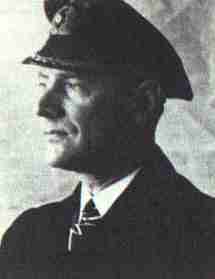
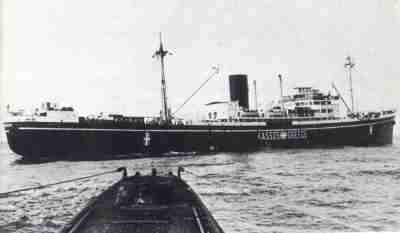
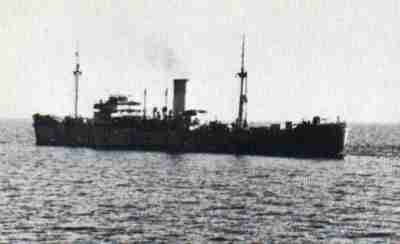
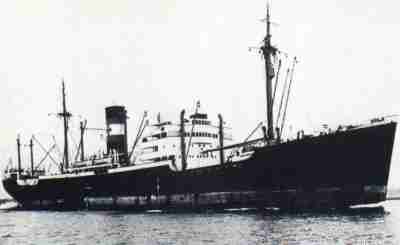
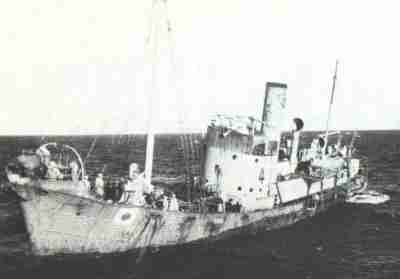
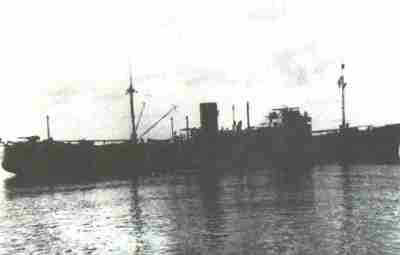
The raider KMS Pinguin, also known as Schiff (Ship) 33, was the
fifth to set sail. Pinguin was originally the merchantman
Kandelfels, sister ship to Goldenfels (later
KMS Atlantis), and built in 1936 by
Deschimag. Captain Ernst-Felix Krüder took the refitted Pinguin
out of Gotenhaven on 15 June 1940 to start her 328-day long cruise. She
slipped through the Denmark Strait and sank her first victim, the
British freighter Domingo de Larrinage, on 31 July in the
Atlantic Ocean near the equator.
Next Pinguin ventured into the southern Indian Ocean, where she
captured or sank her second to seventh victims. The seventh victim,
Storstad, a Norwegian tanker, was deliberately captured intact
and extemporaneously converted to accommodate 110 mines. Krüder and
his navigator, Lieutenant Wilhelm Michaelsen, had meticulously worked
out a plan to mine six Australian and Tasmanian channels with the fewest
mines in the least time possible. Pinguin and the new auxiliary
minelayer Passat, ex-Storstad, carried out the plan which
the Seekriegsleitung (naval operational staff) deemed "outstanding in
its planning, preparation and execution".
Life on board was barely tolerable. The ship was crowded, the food
rotten, and once the latrine buckets were mixed with those for drinking
water. Krüder netted his 11th victim before turning southward to prey
on the Norwegian Antarctic whaling fleet. Pinguin wandered in
the iceberg-strewn ocean and stalked the fleet. In two days, 14-15
January 1941, Krüder captured 14 whalers and some 20,500 tons of whale
oil worth about $4.1 million. The 11th whale catcher captured was
renamed Adjutant and assigned to the proud adjutant Ensign
Hans-Karl Hemmer to be used as a scout for Pinguin. The rest
was sent to France as prizes.
Krüder then decided to prowl the Mozambique track, where he sank his
next three victims in relatively quick succession. However, the last
two victims radioed and the net was closing in on the raider. The
British sent the heavy cruiser Cromwell, light cruiser
Hawkins and carrier Eagle to corner Pinguin.
On 8 May, only one day after Krüder got his last victim, Pinguin
was sighted by Cromwell's seaplane. The British cruiser gave
chase. Pinguin hoisted her battle flag and opened fire when
Cromwell was 10,500 yards away, despite having 130 mines on
board. The cruiser took some hits from the raider, but at 1726 a four-gun
salvo from Cromwell found its mark. One shell detonated in
Pinguin's mine compartment, resulting in a terrible explosion that
ripped her into pieces. Only 25 of the 225 Allied prisoners were rescued,
while 60 Germans survived and 342 others perished, including captain
Krüder.
Adjutant's captain Hemmer and his crew waited at the planned
meeting point with Pinguin and when the bad news broke, said
goodbye to their fallen comrades with three hurrahs and the record
"Goodbye, Johnny".
| Click on one of the thumbnails below to view the full picture. | |
 |
Technical data and/or diagram of KMS Pinguin. |
 |
An overview of the tactics used by the raiders that led to their enormous success. |
 |
A map showing Pinguin's journey. |
 |
Ernst-Felix Krüder, captain of Pinguin. |
 |
The U-boat UA approaches Pinguin to take abroad torpedoes which the latter has brought for her. July 18 1940. |
 |
Pinguin in the Baltic in April 1940. She was engaged in training her crew in radar and torpedo work, and as a target-ship for other vessels whose crews were likewise being trained. The photograph was taken from KMS Widder. |
 |
The motorship Kandelfels of the Hansa Line of Bremen. She was to become Pinguin. |
 |
Whale catcher Adjutant, later auxiliary minelayer. |
 |
Another photo of Pinguin. |
Back to German Auxiliary Cruisers Page
Back to Kriegsmarine Page
Back to Homepage